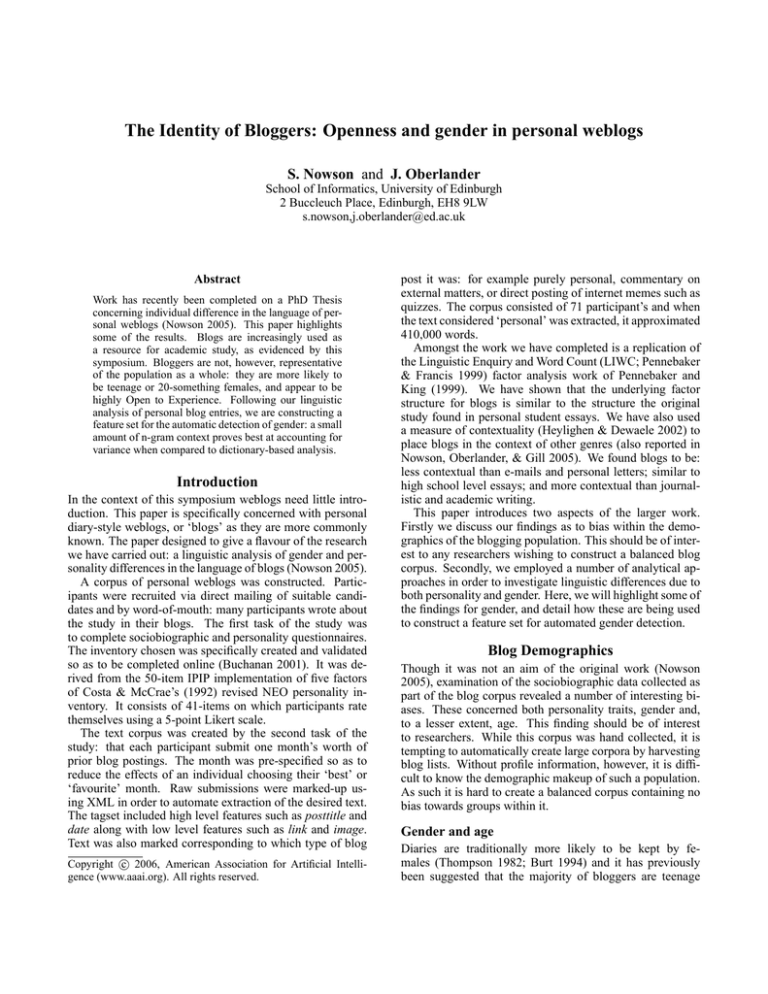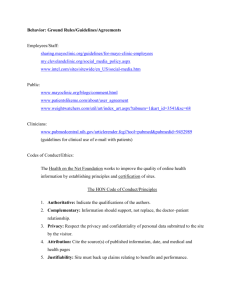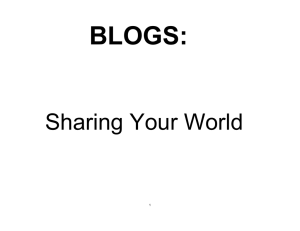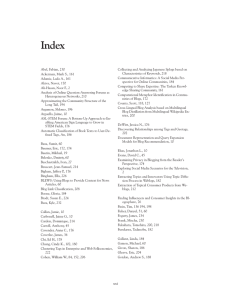
The Identity of Bloggers: Openness and gender in personal weblogs
S. Nowson and J. Oberlander
School of Informatics, University of Edinburgh
2 Buccleuch Place, Edinburgh, EH8 9LW
s.nowson,j.oberlander@ed.ac.uk
Abstract
Work has recently been completed on a PhD Thesis
concerning individual difference in the language of personal weblogs (Nowson 2005). This paper highlights
some of the results. Blogs are increasingly used as
a resource for academic study, as evidenced by this
symposium. Bloggers are not, however, representative
of the population as a whole: they are more likely to
be teenage or 20-something females, and appear to be
highly Open to Experience. Following our linguistic
analysis of personal blog entries, we are constructing a
feature set for the automatic detection of gender: a small
amount of n-gram context proves best at accounting for
variance when compared to dictionary-based analysis.
Introduction
In the context of this symposium weblogs need little introduction. This paper is specifically concerned with personal
diary-style weblogs, or ‘blogs’ as they are more commonly
known. The paper designed to give a flavour of the research
we have carried out: a linguistic analysis of gender and personality differences in the language of blogs (Nowson 2005).
A corpus of personal weblogs was constructed. Participants were recruited via direct mailing of suitable candidates and by word-of-mouth: many participants wrote about
the study in their blogs. The first task of the study was
to complete sociobiographic and personality questionnaires.
The inventory chosen was specifically created and validated
so as to be completed online (Buchanan 2001). It was derived from the 50-item IPIP implementation of five factors
of Costa & McCrae’s (1992) revised NEO personality inventory. It consists of 41-items on which participants rate
themselves using a 5-point Likert scale.
The text corpus was created by the second task of the
study: that each participant submit one month’s worth of
prior blog postings. The month was pre-specified so as to
reduce the effects of an individual choosing their ‘best’ or
‘favourite’ month. Raw submissions were marked-up using XML in order to automate extraction of the desired text.
The tagset included high level features such as posttitle and
date along with low level features such as link and image.
Text was also marked corresponding to which type of blog
c 2006, American Association for Artificial IntelliCopyright gence (www.aaai.org). All rights reserved.
post it was: for example purely personal, commentary on
external matters, or direct posting of internet memes such as
quizzes. The corpus consisted of 71 participant’s and when
the text considered ‘personal’ was extracted, it approximated
410,000 words.
Amongst the work we have completed is a replication of
the Linguistic Enquiry and Word Count (LIWC; Pennebaker
& Francis 1999) factor analysis work of Pennebaker and
King (1999). We have shown that the underlying factor
structure for blogs is similar to the structure the original
study found in personal student essays. We have also used
a measure of contextuality (Heylighen & Dewaele 2002) to
place blogs in the context of other genres (also reported in
Nowson, Oberlander, & Gill 2005). We found blogs to be:
less contextual than e-mails and personal letters; similar to
high school level essays; and more contextual than journalistic and academic writing.
This paper introduces two aspects of the larger work.
Firstly we discuss our findings as to bias within the demographics of the blogging population. This should be of interest to any researchers wishing to construct a balanced blog
corpus. Secondly, we employed a number of analytical approaches in order to investigate linguistic differences due to
both personality and gender. Here, we will highlight some of
the findings for gender, and detail how these are being used
to construct a feature set for automated gender detection.
Blog Demographics
Though it was not an aim of the original work (Nowson
2005), examination of the sociobiographic data collected as
part of the blog corpus revealed a number of interesting biases. These concerned both personality traits, gender and,
to a lesser extent, age. This finding should be of interest
to researchers. While this corpus was hand collected, it is
tempting to automatically create large corpora by harvesting
blog lists. Without profile information, however, it is difficult to know the demographic makeup of such a population.
As such it is hard to create a balanced corpus containing no
bias towards groups within it.
Gender and age
Diaries are traditionally more likely to be kept by females (Thompson 1982; Burt 1994) and it has previously
been suggested that the majority of bloggers are teenage
girls (Orlowski 2003). In fact a recent study (Herring et al.
2004) found that while each gender accounts for about half
of all weblogs, personal blogs are dominated by females of
teen age and preferred by females in general.
Indeed, of the 71 bloggers in our corpus, there were 47
females and 24 males, with average ages 27.8 and 29.4 respectively. These are similar averages but the distribution
of participants within age ranges differs between genders.
Figure 1 shows the number of both male and female participants, along with the total, that lie within each age range.
wrote an average of 251 words in each post (SD 186), while
men wrote 194 words (SD 117; a non-significant difference).
It is clear therefore, that not only are personal weblogs
dominated by younger females, but that females also spend
more effort blogging than men. This is interesting for academics wishing to automatically cull a blog corpus from the
internet. It is likely that the corpus will be dominated by
females, not only in number, but more importantly in word
count. Gender cannot always be determined automatically
from blogs. Herring et al. (2004) determined the gender of
94% of the authors in their collection by using:
names, graphical representations (if present), and the
content of blog entries (e.g., references to “my husband” resulted in a “female” gender classification, assuming other indicators were consistent).
In our study author information was carefully collected, requiring questionnaires from participants in which they specified their gender.
Personality
Figure 1: The number of participants within each age range,
by gender and in total
Whilst teenagers are not the majority group here, participants under 30 clearly dominate. These younger groups also
consist of many more females than they do males. This
would seem to support earlier suppositions that there are
more young female bloggers than any other sub-group.
However, it is not just the raw number of men and women
bloggers that could have a biasing effect on a corpus. Previous studies of CMC (Herring 2000) have found that women
generated shorter posts than men to discussion lists and news
groups. However, these studies have tended to focus on
work-based groups, and findings also suggest that women
are less confident posting, often feeling intimidated by their
male colleagues. Blogs, by contrast, are personal and individually written, closer to situations in which women were
reported to participate to a greater extent.
Our blog corpus consists of approximately 410,000
words. The 47 females and 24 males provide approximately
320,000 and 90,000 words across 1400 and 450 posts respectively. This means that while the men wrote an average of about 3700 words in the month, females wrote 6800
each, almost double (despite large standard deviations, this
is a significant difference: t(69) = 2.315, p < .05). This is
reflected not only in longer posts, but in more frequent postings: women wrote on average 30 personal posts in a month
(SD 22.7) while men wrote only 19 (SD 11.6; this is also
a significant difference: t(69) = 2.196, p < .05); women
It is not just in gender and age that there is a bias: our studies
have also investigated personality. The most intuitive bias
one would expect in bloggers relates to their level of Extraversion. There is much written on the web that discusses
the idea of keeping a blog as ‘exhibitionism’ and ‘mental
masturbation.’1 This suggests that bloggers are perceived as
Extraverts. This is plausible, since bloggers describe details
of their lives to anybody who is interested. This is consistent
with Extraverts’ greater desire to communicate (McCroskey
& Richmond 1990).
A plausible counter argument, however, concerns the perceived anonymity of the online world. Bloggers write at a
distance from their readers and can conceal their identity if
they so wish. This suggests that bloggers may be Introverted
by nature. This too seems plausible since it is easy to imagine Extraverts confiding with friends directly about their activities and thoughts, while Introverts might prefer to communicate through a potentially anonymous written medium.
In addition to this, a recent study has found that one common motivation for blogging is the author’s desire to be a
writer (Li 2005): writers are generally perceived to be Introverts, due to the solitary nature of the working environment.
By plotting the distribution of Extraversion scores we can
test this hypothesis. Our study concluded that in fact bloggers are neither Extrovert nor Introvert. It is clear from figure 2 that whilst there does appear to be a slight Extravert
bias, the distribution is a good approximation of the normal
curve, with a wide range of scores.
The same can also be said of Neuroticism, Agreeableness
and Conscientiousness, though there appears to be a slight
bias in favour of high Agreeableness. Openness, however, is
another matter. The two main observations that can be made
from figure 3 are that the data is both unevenly distributed
and significantly not normal. The lowest possible score on
the Openness scale is 7, yet the lowest score from the blog
1
See http://jilltxt.net/?p=85 for discussion and rebuttal.
to imagine that only the most open of individuals are prepared to do so.
From personal correspondence with Tom Buchanan, one
of the authors of inventory used here, it is clear that the
‘Open blogger’ hypothesis will remain just that. Whilst
it is plausible, without a comparison sample such as nonbloggers recruited and tested in the same way, the exact
cause of this anomaly cannot be determined.
Towards Gender Identification
Figure 2: Distribution of Extraversion scores
data is 18, which only one participant scored. Conversely, 10
participants scored the maximum 35 points, with 8 scoring
34.
Figure 3: Distribution of Openness scores
Ignoring the unevenness, it is clear there is a very heavy
bias toward scoring high on Openness. This may be indicative of the nature of bloggers, that they are very Open individuals. It certainly seems plausible that people who post
details of their lives online could be described as open. Of
course, it is possible that this result only reflects the bias
among those who chose to submit data. Participation required participants to submit personal details and it is easy
The bulk of our work has employed linguistic analysis to
identify language differences due to individual differences.
Whilst this has also been carried out for the personality
traits, here we discuss just the gender findings. Investigation
has revealed a number of features that appear to lend themselves well to use for distinguishing between the language
of males and females.
There is much previous work on gender identification
through language, both automatic (Koppel, Argamon, &
Shimoni 2002; Argamon et al. 2003) and otherwise (see
Herring 2000, Pennebaker, Mehl, & Neiderhoffer 2002 for
reviews). Gender language differences have also been previously investigated in blogs (Huffaker 2004).
The first approaches we employed were dictionary-based
content analyses. We used both the LIWC, which has previously been used to investigate language in blogs (Cohn,
Mehl, & Pennbaker 2004) and following Gill (2004), a novel
application of the MRC Psycholinguistic database (Coltheart 1981; Wilson 1987). Examining those variables which
showed at least a marginally significant relationship with
gender (p < .1) confirmed prior findings: women have a
more immediate style of writing, use more pronouns and
words reflecting social processes, emotions and physical
states; men by contrast talk more about external matters,
they use more articles and (according the MRC) more frequent, less concrete language.
We then turned to more data-driven approaches. The first
was the measure of contextuality mentioned earlier (Heylighen & Dewaele 2002). This was a measure derived from
the notion of deixis: that some parts-of-speech (POS) generally (though not invariably) require more context in order
to disambiguate them than others. For example, the pronoun in ‘get it’ is easier to resolve with context such as ‘see
the ball by the front door, get it’. Women were shown to
have a significantly more contextual style of writing than
men (t(66) = −2.75, p < .01). This difference also holds
in other genres such as fiction and email, though not in the
rather formal field of academic writing, when the genders
score similarly (Nowson, Oberlander, & Gill 2005). Since
this measure is based POS, we could also see that once again
men use more articles and fewer pronouns, but also more
nouns, prepositions and fewer verbs.
We also examined context as reflected in the use of distinctive word collocations. By using the G2 log-likelihood
statistic (Dunning 1993), bi- and trigrams were identified
which occurred with significant relative frequency distinctly
in the language of one gender over the other. Male n-grams
appear to consist of mostly function word combinations (e.g.
[on a] and [of the]), while females were characterised by
Feature Set
No.
Accuracy
Precis.
Recall
LIWC
MRC
N-grams
19
7
125
77.5%
63.4%
93.0%
.749
.326
.915
.749
.479
.923
All
157
91.5%
.901
.916
control for the simple fact that there are a greater number
of n-gram features, the set was reduced by removing those
feature with lowest significance. The results of the n-gram
only features sets can be seen in figure 4. As with previous
studies, small feature sets can still prove remarkably accurate for classification.
Table 1: SVM classification of gender
phrases with content words. There were also many more ngrams containing pronouns. The n-grams were selected on
the basis that they occurred in at least 1/3 of the participants
in each group (8 males and 15 females). Individual influence
was then further reduced by determining those n-grams that
showed a statistically significant relationship with gender.
In order to compare the effectiveness of the features
our studies had revealed, we have conducted simple machine classification experiments. A support vector machine
(SVM) approach was used to classify author gender. SVMs
have previously been shown to be generally better than
Naı̈ve Bayes (Joachims 1998). As described above, the
features chosen were those variables which had previously
shown at least a marginally significant relationship with gender.
Similar features such as n-grams and POSs have been
used previously in automatic text classification. Pang, Lee,
& Vaithyanathan (2002) compared approaches, including
SVM, to classify film review sentiment as positive or negative. They also compared bag-of-features sets including
unigrams, bigrams and POS tags, which varied in size between 3000 and 32000 features. Argamon and Koppel (Koppel, Argamon, & Shimoni 2002; Argamon et al. 2003) have
employed both lists of function words and POS n-grams to
begin with over 1000 potential features in the classification
of gender. Their approach however enabled them to select
those features most useful for classification. Reducing their
features set initially improved results. However, there was
only a 5% loss of performance overall with as few as 8 features. As already discussed, it is our previous work that informs our feature selection.
The WEKA work bench was used to implement 10-fold
cross validation studies on the 71 datafiles. Accuracy results, from the features sets of this work, alongside average
precision and recall scores, can be seen in table 1.
Note that due to the imbalance in gender in the corpus
the base rate for this study is 66.2%, achieved simply by
classifying all participants as females. The lower than base
rate score from the MRC features is due to two females being the only participants classfied as male. It is also worth
noting that the experiment reported here is simply an initial
starting point for our work in this direction; there has been
no attempt to refine the classifier or feature set. There is also
room for overfitting since the feature set is used to classify
the very data from which it is derived.
However, despite these obvious limitations, it is clear that
using the context-based n-gram set appears more accurate
than using either of the dictionary-based approaches. To
Figure 4: Accuracy of reduced n-gram sets
Discussion
The dominance of context-based n-grams is echoed in our
studies and results for personality. It is planned that these
studies will provide the basis for feature sets for automatic
classification of not just gender but personality classes. We
intend to further investigate differing approaches to machine
classification, as well as alternative feature selection methods to our own empirical methodology. It is also hoped that
our so far promising results will be replicated with the use
of unseen data.
Final words
This paper is intended to give just a flavour of our work on
the language of personal weblogs. It has highlighted apparent biases in the demographics of the weblog community,
which are worth noting when constructing a corpus. It has
also briefly introduced our work leading towards automatic
classification of blogger gender from text.
Acknowledgements
Our thanks to Judy Robertson for her helpful input. The
first author gratefully acknowledges support from the UK
Economic and Social Research Council, studentship number
R42200134353.
References
Argamon, S.; Koppel, M.; Fine, J.; and Shimoni, A. 2003.
Gender, genre, and writing style in formal written texts.
Text 23(3).
Buchanan, T. 2001. Online implementation of an IPIP
five factor personality inventory [on-line]. Retrieved 25th
October, 2005, from http://users.wmin.ac.uk/
∼buchant/wwwffi/introduction.html.
Burt, C. 1994. Prospective and retrospective accountmaking in diary entries: A model of anxiety reduction and
avoidance. Anxiety, Stress & Coping: An International
Journal 6(4):327–340.
Cohn, M.; Mehl, M.; and Pennbaker, J. 2004. Linguistic markers of psychological change surrounding september 11. Psychological Science 15:687–693.
Coltheart, M. 1981. The MRC psycholinguistic database.
Quarterly Jour. of Experimental Psychology 33A:497–505.
Costa, P., and McCrae, R. 1992. Revised NEO Personality Inventory (NEO-PI-R) and NEO Five-Factor Inventory
(NEO-FFI): Professional Manual. Odessa, FL: Psychological Assessment Resources.
Dunning, T. 1993. Accurate methods for the statistics
of surprise and coincedence. Computational Linguistics
19(1):61–74.
Gill, A. 2004. Personality and Language: The projection
and perception of personality in computer-mediated communication. Ph.D. Dissertation, University of Edinburgh.
Goldberg, L. 1993. The structure of phenotypic personality
traits. American Psychologist 48(1):26–34.
Herring, S.; Kouper, I.; Scheidt, L.; and Wright, E. 2004.
Women and children last: The discursive construction of
weblogs. In Gurak, L.; Antonijevic, S.; Johnson, L.;
Ratliff, C.; and Reyman, J., eds., Into the Blogosphere;
Rhetoric, Community and Culture of Weblogs. University of Minnesota. Retrieved October 25th, 2005, from
http://blog.lib.umn.edu/blogosphere/
women and children.html.
Herring, S. 2000. Gender difference in CMC: findings and
implications. Computer Professionals for Social Responsibility Journal 18(1).
Heylighen, F., and Dewaele, J.-M. 2002. Variation in the
contextuality of language: an empirical measure. Foundations of Science 7:293–340.
Huffaker, D. 2004. Gender similarities and differences
in online identity and language use among teenage bloggers. Master’s thesis, Graduate School of Arts and Sciences, Georgetown University.
Joachims, T. 1998. Text categorization with support vector
machines: Learning with many relevant features. In Proceedings of the European Conference on Machine Learning (ECML), 137–142.
Koppel, M.; Argamon, S.; and Shimoni, A. 2002. Automatically categorizing written texts by author gender. Literary and Linguistic Computing 17(4):401–412.
Li, D. 2005. Why do you blog: A uses-and-gratifications
inquiry into bloggers’ motivations. Master’s thesis, Marquette University.
McCroskey, J., and Richmond, V. 1990. Willingness to
communicate: A cognitive view. Journal of Social Behaviour and Personality 5:19–37.
Nowson, S.; Oberlander, J.; and Gill, A. 2005. Weblogs,
genres and individual differences. In Proceedings of the
27th Annual Conference of the Cognitive Science Society,
1666–1671. Hillsdale, NJ: Lawrence Erlbaum Associates.
Nowson, S. 2005. The Language of Weblogs: A study of
genre and individual differences. Ph.D. Dissertation, University of Edinburgh.
Orlowski, A. 2003. Most bloggers “are teenage girls” - a
survey. The Register. Retrieved October 25th, 2005, from
http://www.theregister.co.uk/content/6/30954.html.
Pang, B.; Lee, L.; and Vaithyanathan, S. 2002. Thumbs
up? Sentiment classification using machine learning techniques. In Proceedings of the 2002 Conference on Empirical Methods in Natural Language Processing (EMNLP),
79–86.
Pennebaker, J., and Francis, M. 1999. Linguistic Inquiry
and Word Count: LIWC. Erlbaum Publishers.
Pennebaker, J., and King, L. 1999. Linguistic styles: Language use as an individual difference. Journal of Personality and Social Psychology 77:1296–1312.
Pennebaker, J.; Mehl, M.; and Neiderhoffer, K. 2002. Psychological aspects of natural language use: Our words, our
selves. In Annual Review of Psychology, volume 54. 547–
577.
Thompson, E. 1982. The Makings of the English Working
Class. Harmondsworth: Penguin.
Wilson, M. 1987. MRC psycholinguistic database: Machine usable dictionary. Technical report, Oxford Text
Archive, Oxford.




